
Angel of the North in Gateshead. - Image by PicturesOfEngland.com member Dave Brown (view gallery)

Buckingham Palace, London - Image by PicturesOfEngland.com member Stephan Tzenov (view gallery)
Buckingham Palace is the first home and office of the Royal family in England, and has been the home to British sovereigns since 1837. It is where heads of state visit, and is used for banquets and other state and royal occassions. Originally it was a town house built for the Duke of Buckingham in 1703. It was later purchased by George III in 1762 and used as one of the royal family's London homes. 14 of George III's 15 children were born at the palace. George IV who reigned between 1820-30 employed John Nash to build a new palace around the old Buckingham House. Both he and his brother King William IV who reigned from 1830 to 1837 died before the new palace was fully completed, and so Queen Victoria was the first monarch to live at the palace in 1837, making it the royal family's main London residence. Buckingham Palace is decorated with priceless works of art that form part of the Royal Collection, one of the major art collections in the world today. It is also one of the worlds most familiar buildings and over 50,000 people visit the palace each year as guests to banquets, lunches, garden parties and receptions. During August and September when The Queen makes her annual visit to Scotland, the Palace's nineteen state rooms are open to visitors who get to see all the lavish furnishings and some of the most priceless works of art in the world. Also open to the public at this time is the gardens which are a haven for wildlife and offer great views of the garden front of the palace and the 19th century lake
ID#35
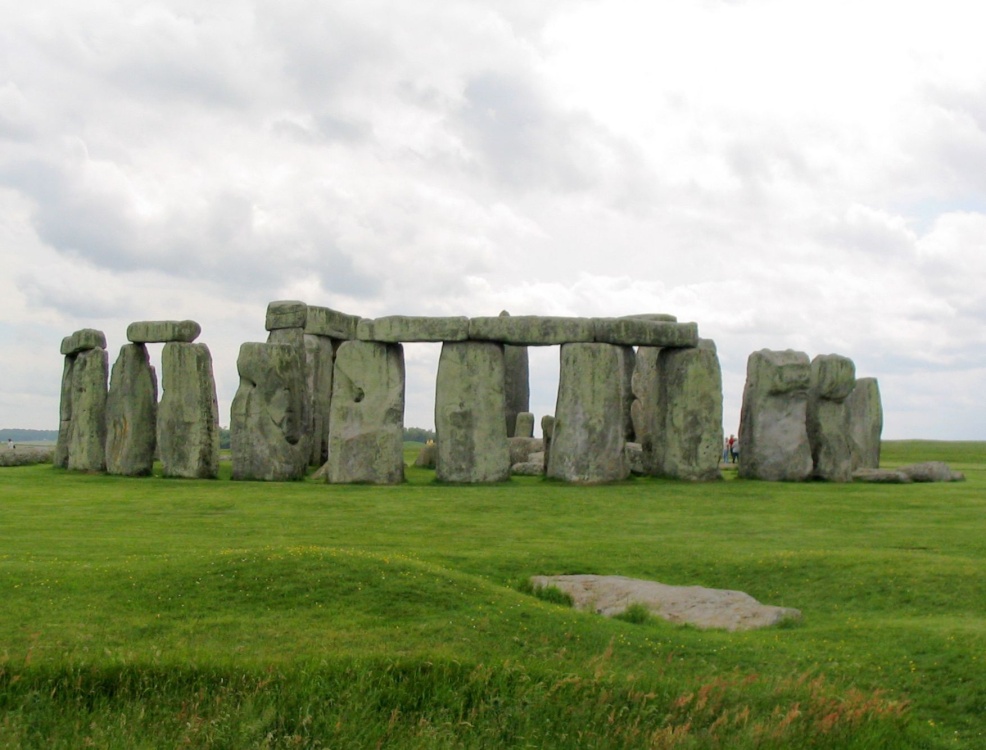
Stonehenge (2) - June 21, 2003 - Image by PicturesOfEngland.com member Judith Hays (view gallery)
Stonehenge is one of the most famous prehistoric monuments in the world and one of England's most iconic landmarks, consisting of a ring of large standing stones that reach 13 feet high and weigh in at around 25 tonnes.
It is believed to have been constructed between 3000 BC and 2000 BC, with the surrounding circular eathworks dating back to around 3100 BC. Stonehenge is a UNESCO World Heritage Site, managed by English Heritage and owned by the Crown.
Its purpose has been the topic of much debate, with theories ranging from a druid temple, to that of a solar calendar for ancient astronomers, but strong evidence now suggests that it was used as some sort of burial site and ceremonial complex, after hundreds of human bones were discovered at the site.
ID#155

Durdle Door, Dorset - Image by PicturesOfEngland.com member Paul Hilton (view gallery)
On a coast of fabulous high white cliffs there are few views to rival the spectacular Durdle Door. This natural phenomena, carved by the sea must rank as one of the most photographed scenes on the Jurassic Coast, it is certainly one of the coastal wonders of Britain.
It is a beautiful place, a shingle cove surrounded by rocks where a 'door' has been formed by the sea eating away at relatively soft rock, leaving an exquisite open arch of hard Portland stone. Crystal clear waters flow through the door, sweeping softly up the pretty sloping beach which is used for bathing and this, together with other little coves make it a pleasurable place for sub-aqua enthusiasts.
Lying a short distance from famed Lulworth Cove where fascinating arms of rock enfold pools of water left by a retreating tide, make this a picturesque and exciting place to explore. Lulworth has delightful thatched cottages, pleasant shops and friendly inns and quaint shops, and cafe's. At nearby Bat's Head, a smaller arch carved by waves can be seen - this is affectionately known as the 'mousehole' it is beneath massive rock formations jutting out into the sea. From the mossy headland above there are seascapes of incomparable splendour.
Places to visit include: Bowleaze Cove, Kimmeridge Bay, Swanage Railway, Corfe Castle (NT) and Wareham - pretty market town.
ID#26

Houses of Parliament - Image by PicturesOfEngland.com member David Thomas (view gallery)
The Houses of Parliament, also known as The Palace of Westminster has been the seat of the two Houses of Parliament called the House of Lords and the House of Commons since 1512. The Commons is made up of elected Members of Parliament (MP's) from different political parties (Labour, Liberal Democrates, Conservative, etc). The party with the most MP's forms the Government of England, with its leader becoming Prime Minister of England. MP's from other parties make up the Opposition. The Commons debate legislations in both houses before passing them through as law.
Originally built for Edward the Confessor in 1042, The Palace of Westminster has been the place where virtually all English Monarchs since William the Conquerer have been coronated. In 1512 a fire broke out and the palace stopped being a royal residence, but the Lords continued to meet there. The Palace of Westminster has been home to the English Parliament ever since.
Another fire raged through the palace in 1834 destroying much of it, except the Jewel Tower and Westminster Hall which dates from 1097 and its hammerbeam roof dating from the 14th century. This part of the palace was saved by Lord Melbourne, the Prime Minister at the time who saved the great hall by arranging for the fire engines to be brought right into the hall and then he personally supervised the fire fighting. The present magnificent building is Mock Gothic and was designed by Victorian Architect Sir Charles Barry and was finished in 1870. On the main picture above you will see the two main towers. The one on the right of the picture is Big Ben, and the tower on the left is Victoria Tower which contains 1.5 million acts of Parliament passed since 1497. Victoria Tower also flies the union jack whenever Parliament is sitting.
Every November the Fifth, England comemorates the death of Guy Fawkes, who along with others tried to blow up the king and the Houses of Parliament back in 1605. On this date in England fireworks fill the sky nationwide and bonfires light in every town and village
ID#33

Windsor Castle from the Thames. Taken Aug/Sept 2003 - Image by PicturesOfEngland.com member Andrew Irving (view gallery)
There are over 4,000 castles in England, many of which are incredible landmarks and instantly recognisable to many, however as this is a list of the most famous landmarks, there is one castle inparticular that is perhaps better known throughout the world due to it being a place of royal residence, as it has been for around 950 years, and that is Windsor Castle - royal residence of the Queen, and the largest inhabited castle in the world.
Founded by William the Conqueror in the 11th century, Windsor Castle is where the Queen spends most of her weekends and several full weeks at a time in residence as she hosts guest such as politicians, public figures, overseas monarchs and presidents, and many services are held including the Order of the Garter and the Royal Ascot race meeting.
Within the famous grounds is St George's Chapel, which is one of the finest examples of Gothic architecture in England, and which remains an active centre for worship, and a place for royal wedding celebrations. The Chapel is also the place where Queen Elizabeth The Queen Mother lies buried with her husband, King George VI, and also Princess Margaret, her younger daughter. In the famous Round Tower can be found the Royal Archives and the Royal Photograph Collection.
The castle is open to the public all year round and really is a must-visit place.
To plan your visit, please visit https://www.rct.uk/visit/windsor-castle
ID#191

Canterbury Cathedral over the wall - Image by PicturesOfEngland.com member Mobscooter (view gallery)
This magnificent cathedral has been a place of pilgrimage for hundreds of years. It was the scene of Thomas a' Becket's murder in 1170, the spot is marked by a plaque, later he was made a Saint, there is a magnificent shrine to him in the Cathedral.
The building is renowned for its fantastic Norman crypt, believed to be the largest in the world; it is also known for its wonderful series of chapel's. The impressive Lady Chapel is quite possibly the best of these, it has fine stone screens - a gift of the Black Prince who wanted the chapel to be his final resting place. The Black Prince's Chantry is an early Norman chapel once used by the Huguenots; it takes its name from alterations made by the Black Prince. Two of the oldest chapels in the cathedral are opposite the north transept, these are dedicated to St.Mary Magdalene and St.Nicholas. St. Gabriel's chapel has Byzantine frescoes dating from the early 1100's in here visitors can see pillars carved with figures and animals. And in the great east crypt is yet another magnificent chapel of our Lady, this has a ceiling decorated with crowns carrying the letter "M".
Originally the cathedral was founded in the year 597, but nothing of these buildings remain. The buildings we see today are the product of early craftsmen following the Conquest. Much of the glory of Canterbury Cathedral rests with two men, William of Sens, who designed the choir and apse after the fire of 1174, and Henry Yevele, who designed the nave in 1374. Late in the 15th-century the central Bell Harry Tower was added.
Superb elaborate monuments can be seen throughout the cathedral, and in Trinity Chapel on the south side visitors can see the magnificent tomb of Edward the Black Prince, son of Edward III, who died in 1376. On the north side lie the bodies of King Henry IV and his wife Joan of Navarre, they rest in a canopied tomb with splendid alabaster effigies.
Historically, Thomas a' Becket is Canterbury Cathedral's most famous Archbishop, but Thomas Cranmer was Archbishop here during the Reformation, it is he that compiled the early Prayer Books for what was to become the established Church of England. During the reign of Mary I when the Catholic religion was restored Cardinal Pole was anointed Archbishop. Of the men who served as Archbishop during the reign of Elizabeth I, the two best known are John Whitgift and Matthew Parker.
Most recently in the 20th-century, the late Pope John Paul, leader of the Roman Catholic Church met with Archbishop John Runcie in 1982 at Canterbury Cathedral. The two men knelt together in silent prayer at the shrine of Thomas a' Becket.
This is an awesome place which is undeniably beautiful, it's rich historic past is illustrated at every turn you make and this applies to the magnificent architecture of the exterior as much as it does to its glorious interior.
To visit Canterbury Cathedral is to part-take of one of life's most rewarding spiritual experiences.
ID#8874

Dover - Image by PicturesOfEngland.com member Zbigniew Siwik (view gallery)
Often called the Gateway to England, the white cliffs of Dover along the southern coast of England are without doubt one of the country's most famous landmarks, and have also become a symbol of freedom and hope, being strongly associated with the wartime defence of Britain, after the popular World War 2 song by Dame Vera Lynn "(There'll Be Bluebirds Over) The White Cliffs of Dover" -
There'll be bluebirds over
The white cliffs of Dover
Tomorrow, just you wait and see
There'll be love and laughter
And peace ever after
Tomorrow, when the world is free
During the various wars throughout the centuries, the white cliffs of Dover were often a soldiers last sight of England as he went off to war, and should he survive, the cliffs were often the first thing he would see on his return, and were thus a great cause for excitement and celebration having made it home.
Today, the White Cliffs of Dover are still a great cause for celebration as one of England's most fantastic natural features standing some 350 feet high, and stretching for 8 miles along the southern coast of England.
ID#9175

Beach and Tower - Image by PicturesOfEngland.com member Ken Bolton (view gallery)
Blackpool, long famous for its vast illuminated Golden Mile, commenced its rise to fame way back in the Victorian Era when the famous seafront consisted of no more than a single row of houses. In those far off days the resort was quiet, serene and just another of England's quaint fishing villages. Then came the building of the railways and the building of Central Station in 1846, and from this point onwards, tourists flocked to Blackpool en-mass. The North Pier was built in 1863 and the Winter Gardens were established in 1876. Thus, the future of this quiet backwater as a mainline tourist resort, was assured. For good or ill, this famous resort has never looked back. The number of visitors doubled, trebled until it reached its peak of around 8 million visitors during the mid-1960's. Today even greater number is estimated.
The resort is probably best known for its famous Tower, built in 1894 it was for many years, at a soaring height of 518ft, the highest building in England. The Tower could be seen from Cumbria in the north of England and from the Hills of North Wales. From the top of this famous building there are magnificent views over the town and surrounding coastline. From this unique vantage point there is an unrivalled view of an ocean tinged gold by the rays of a setting sun. Beneath this fabulous view lies the bustle of the Golden Mile where one can experience anything from a freak show to a fortune teller! The mile is strewn with bars, disco's, amusement arcades, pubs and restaurants. The whole area is a riot of colour from the millions of colourful lights that form the famous illuminations.
Each of the three piers is brightly lit and has its own theatre presenting live entertainment. Many of todays (and yesterdays) theatrical stars have started their careers in the theatres and pubs of Blackpools golden mile. The vast Pleasure Beach is known to have offered some of the first and most thrilling amusement park rides in Britain. The whole area is brash, bold and breezy. It is a place of great fun for the very young and the young at heart. A fish and chip supper straight from paper wraps whilst strolling along the prom is a must, so are welks and cockles from a fish bar at lunch time.
A few short miles away is the more sedate resort of Lytham St. Annes, home to one of the countries great championship golf courses. All along this coast you will find mile after mile of gorgeous golden beaches and the choice is yours; sand and sun, a gentle round of golf, serious shopping in Lytham followed by a fun filled night under the stars and bright lights of Blackpool. Hectic, did I hear you say, some would say - one of lifes great experiences and definately not to be missed!
ID#243
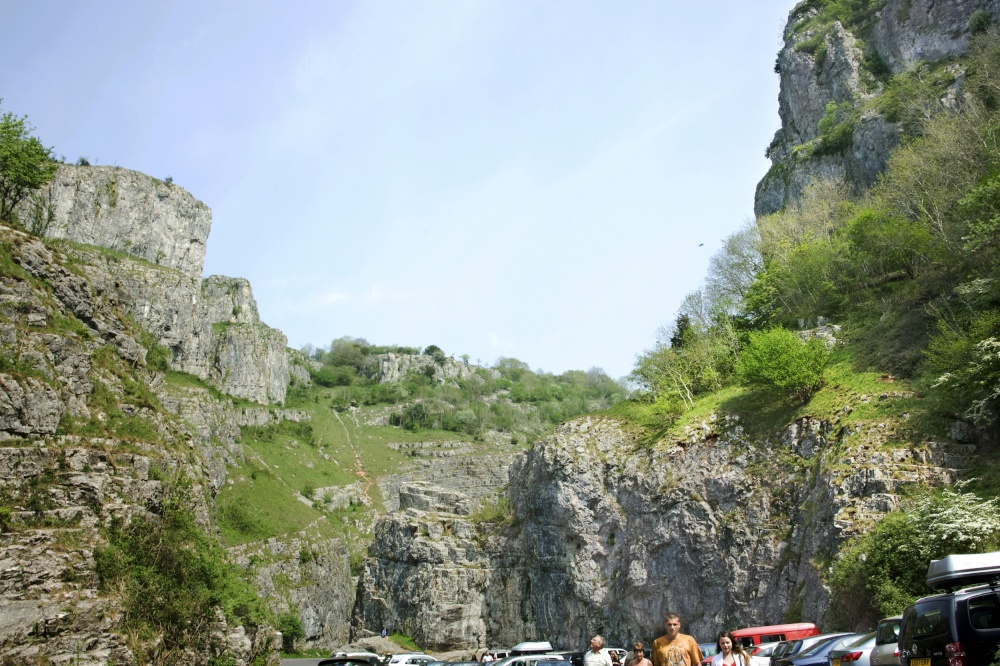
Cheddar Gorge - Image by PicturesOfEngland.com member Lucia Ladomerszky (view gallery)
Each year, thousands of visitors are drawn to Chedder and the wild beauty of the magnificent hills through which this famous gorge is cut. Often called 'Englands Grand Canyon' Chedder Gorge was carved out by a river that now runs underground. On each side of the road that leads down to the village, cliffs rise majestically to the great heights of the Mendips Hills that are said to have been home to man and beast for thousands of years. This fact is evidenced by several long barrows that date to the New Stone Age of around 3,000 BC. There is evidence too, of a prosperous Bronze Age period and of Roman occupation. This is an area with a long history which has travelled through turbulent times and has seen various industries come and go. At one time mining featured heavily here, but always, over many centuries, and long before the vast underground caverns were opened for man to explore, farming has been at the heart of the communities that dwell within the Mendips.
It is the tourist attraction of the vast underground caverns that causes thousands of visitors to flock to Chedder. They queue in their hundreds to see the spectacular underground chambers which feature crystalline formations that have been created by water action. The caves are beautifully lit and present the visitor with a magical spectacle which is well worth seeing.
Just as cavers continue to explore the cavernous underground of these hollow, limestone hills, many climbers come here to scale the rock faces of the great cliffs that fill the ancient gorge. Some come quite unprepaired for the weather changes, for in the high upland regions, change comes swiftly, sunlight gives way to swirling mist and it is then that one is easily trapped. Fortunately, Chedder has an experienced rescue team than annually, both saves and helps many inexperienced climbers. One can quite understand the desire to climb these beautiful hills, the scenery all around is quite magical and from the high ridges there are wonderful vistas of the Bristol Channel and Brean Down and, on clear days, the hills of Wales come into view.
This is hallowed ground for the naturalist, the Mendip Hills reveal a rich bounty of flora and fauna. The fragile looking but sturdy Chedder Pink, once gathered in bunches by the tourists of a hundred years or so ago, is now a rare flower and grows only in Chedder Gorge, blooming in the high summer months. In late summer and autumn, many Butterflies can be spotted, they feed on the wild hedgegrow flowers such as red campion and marjoram. Many herbs and berries grow in the wooded areas. Blackberries grow in great profusion, and in cool, spacious openings between the trees you can find rosebay willowherb and paris. The woodland regions are rich with a multiple of trees, there are huge old oaks, towering maples, gracious limes and douglas firs. In spring delicate bluebells and wood anemones grow in abundance forming a splendid carpet in the undergrowth beneath the trees.
In autumn, the delicate colours of spring and summer give way to deeper hues when the leaves of trees and bushes change from green to brilliant red, copper and gold. There is a rare peace to be found in these wooded areas where often all that can be heard is the sound of birdsong from the birds who inhabit these woods.
High on the Hills, narrow lanes wend through ancient hamlets and delightful little villages. The surrounding land is a criss cross of fields hemmed in by leafy hedges and drystone walling. Old farmhouses, strongly built to withstand the icy blast of the winterwinds are surrounded by lush meadows, grazed by cattle and sheep. Here you are a world away from the tourist Chedder below, it is a region of sheer enchantment where every turn offers a fresh delight.
In the village of Chedder you will find many gift shops; Somerset cider is plentiful as is the famous cheese for which this area is renowned. There are several inns and public houses and a couple of traditional fish and chip shops. There is much to do, see and admire in this area but your abiding memory will be the sheer grandeur of the scenery where the highest point echoes the words of the song - On a clear day - for the view is just that - as though you could see forever more!
ID#39

Angel of the North - Image by PicturesOfEngland.com member Iain Mavin (view gallery)
Britain's largest sculpture, The Angel of the North weighs in at 208 tonnes and stands 20 metres high. It was based on artist Antony Gormley's own body and has wings spanning 54 metres.
This huge sculpture overlooks the A1 at Gateshead and at least 90,000 motorists a day will pass it by. It can also be seen on the train journey from London to Edinburgh.
ID#148

Tower Bridge - Image by PicturesOfEngland.com member John Frings (view gallery)
London Tower Bridge was completed in 1894. It is a beautiful piece of Victorian engineering and is one of the many symbols of London. The bridge itself was powered by steam right up until 1976 when the system was electrified. The bridge is 135 ft high and 200 ft wide and in its heyday was opened 5 times a day to let big ships through. The two towers are joined near the top by a catwalk which gives beautiful views along the river Thames.
The bridge now offers The Tower Bridge Experience, which gives interactive displays showing the Bridge in action and detailing its entire history. You also get a walk along the catwalk and a look at the steam engine which once powered the bridge.
ID#31
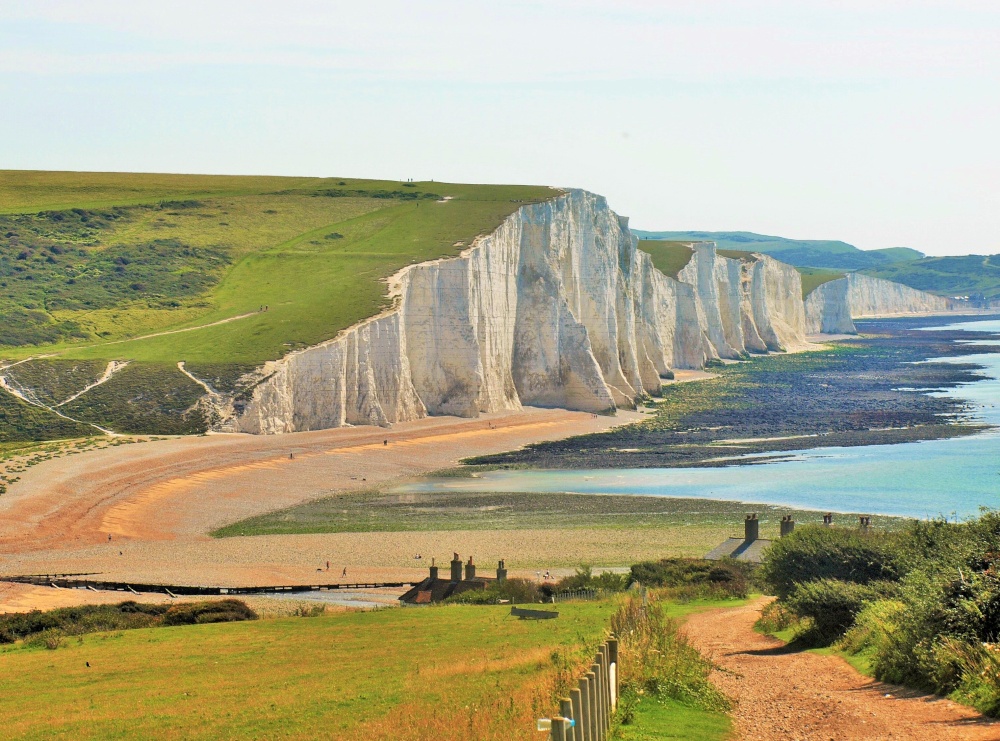
Seven Sisters, East Sussex - Image by PicturesOfEngland.com member Kathleen Brookes (view gallery)
Although not quite as famous as the White Cliffs of Dover further along the coast, these chalk cliffs in East Sussex are just as breathtaking and are often used as a movie/TV stand-in for the Dover cliffs, as being left to erode naturally they remain a brighter white in comparison to the cliffs at Dover which are slightly more green due to protection, which allows plantlife to establish itself.
Notable appearences on TV and film include at the beginning of Robin Hood: Prince of Thieves, at the end of the World War II film Atonement, in the 2015 film Mr. Holmes, the 2019 film Hope Gap, and in the 2020 film Summerland.
ID#9803
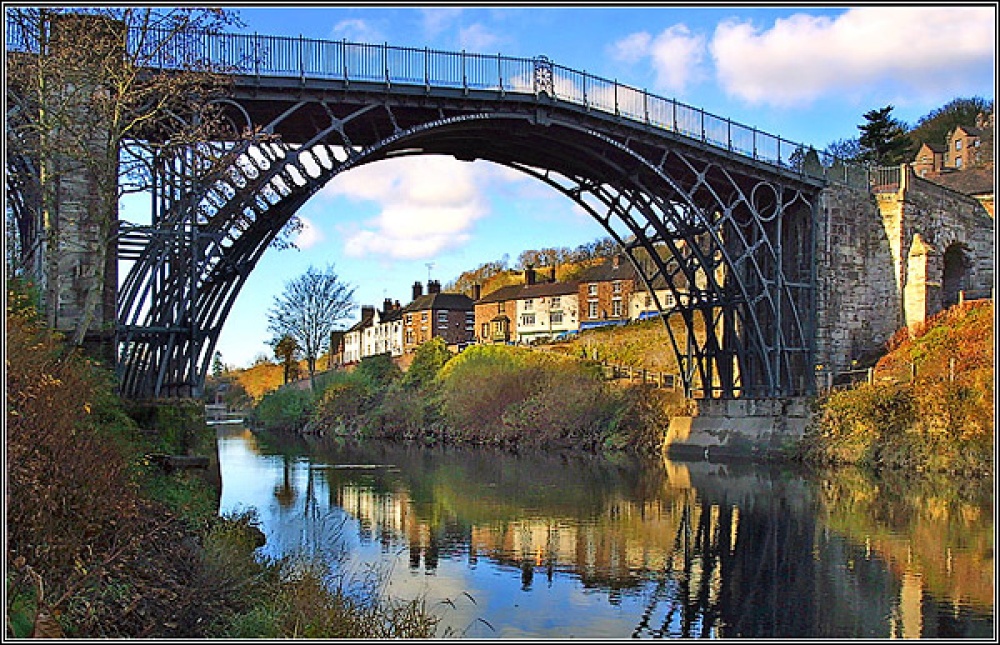
Ironbridge, Telford, Shropshire. UK - Image by PicturesOfEngland.com member John Powell (view gallery)
This town is named for the famous bridge that spans the River Severn - the world's first Iron Bridge. Completed in 1781 it was built by Abraham Darby III to advertise his ironworks at nearby Coalbrookdale. Within a year the worth of Iron as a building material was proven. During that period, a flood had washed away all the other bridges except for this one.
It was the pioneering work of Abraham Darby's grandfather in the iron industry that earned this little town the distinction of being the cradle of the Industrial Revolution. The ironworks at Coalbrookdale saw the birth of the very first Iron wheels, Iron rails, Iron boat, Aquaduct, Iron framed buildings and the famous bridge.
Much of the industrial heritage of Ironbridge and Coalbrookdale is preserved by the Ironbridge Gorge Museum. This is an enchanted valley of working museums and real history. On show are images and objects from an industrial revolution which changed forever not only the great heartland of the Midlands but many other towns and Cities throughout England, if not the World. It is Coalbrookdale that we have to thank for that which is the pride of every English country kitchen - the Aga oven, for it was here that this unique oven was first invented.
Centre of industry this area may be but there is some very pleasant countryside close-by with an abundance of public houses where a genial host will be happy to serve you with a tasty meal and a good pint of his excellent ale.
The Wrekin is a local beauty spot and Benthall Hall owned by the National Trust is well worth a visit. The mighty River Severn meanders merrily throughout this area and at times, is almost in-line with the Severn Valley Steam Railway line which runs from Kidderminster to the nearby town of Bridgenorth.
ID#258

Hadrians Wall - Image by PicturesOfEngland.com member Martin Humphreys (view gallery)
Built in AD 122 under the orders of the emperor Hadrian to guard the northern frontiers of the Roman Empire, Hadrian's Wall is an incredible feat of engineering, crossing 73 miles of northern Britain from Wallsend on the east coast of England, to Bowness-on-Solway in the west. It was made a UNESCO World Heritage Site in 1987.
A common misconception is that the wall was built by Roman slaves, however this is incorrect. The wall was actually built by skilled Roman legionary masons, with labour provided by thousands of auxiliary soldiers. It is thought to have taken around 6 years to complete the wall.
Although initially built to defend Roman controlled Britain from the barbarians in the north, the wall and garrisons stationed along it were often overrun by the barbarians, and the wall was eventually abandoned after 40 years for a new wall of turf in Scotland. However this did not work so the romans reverted back to Hadrian's Wall.
There are many sites where you can visit the wall today, and we recommend visiting the English Heritage website to begin planning your visit to this remarkable British landmark.Their website contains all the information you would need, including a history of Hadrian's Wall and lots of facts and stories.
https://www.english-heritage.org.uk/visit/places/hadrians-wall/
ID#3724

Brighton Pier - Image by PicturesOfEngland.com member Belinda Neasham (view gallery)
Britain is home to the oldest pleasure pier in the world, Ryde Pier on the Isle of Wight which was built in 1813, however the most famous of all Britain's piers is the one at Brighton which was opened in 1899 and is visited by millions of people each year. It is a beautiful treasure from Victorian times and is home to a waterfront theme park with rides, restaurants, arcades and other activities, and of course a beautiful view across the south-coast of England.
ID#10497
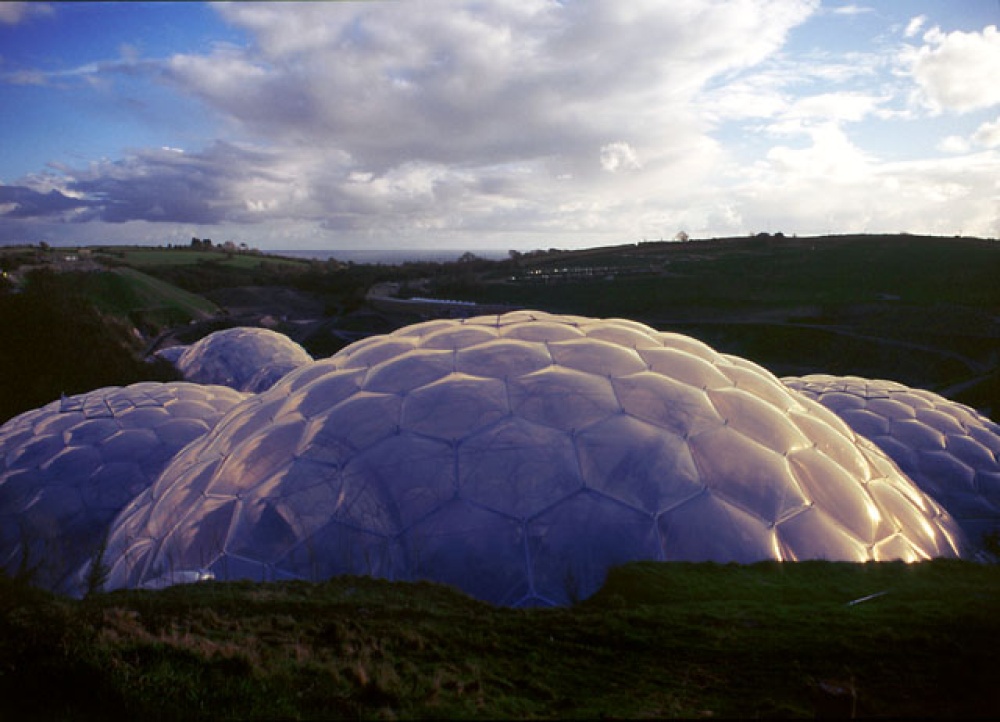
Biodomes of the Eden project in evening light. - Image by PicturesOfEngland.com member Jonathan Charles (view gallery)
Last but not least on this list of famous England Landmarks is the brilliant Eden Project in Cornwall, England, which is a fascinating dome structure containing a collection of plants that are collected from many diverse climates and environments. It was constructed in 2001 to support biodiversity and be educational in the inter-dependence of plants and people, and boasts the world's largest rain forest in captivity, complete with humid jungle, waterfalls, and a rainforest canopy walkway that takes you above the treetops. There is much more to this fantastic world-famous attraction too, such as world-class scultpures and art, 30 acres of wonderful outdoor garden displays, educational centres, and delicious locally-sourced food in the cafes, all making for a great day out to remember.
ID#130

| Article Title | Author | Date |
| Stonehenge | David Coe | 23rd January 2024 |
| Derwent Dam: A Historic Icon in the Heart of Derbyshire | David Coe | 14th January 2024 |
| The Native Trees of England: A Botanical Tapestry | David Coe | 15th December 2023 |
| Stoke-on-Trent: The Potteries Hub | David Coe | 12th December 2023 |
| England's 'Heritage at Risk Register' 2023 | David Coe | 11th December 2023 |
| 10 of the prettiest villages in the Lake District, Cumbria | poe | 16th March 2023 |
| Where to see Daffodil Displays in the South West of England | poe | 3rd March 2023 |
| 10 Famous Landmarks in Dorset | poe | 1st March 2023 |
| List of popular Dorset market towns including market day | poe | 1st March 2023 |
| 10 Best Historic Attractions to visit in York, England | poe | 16th May 2022 |